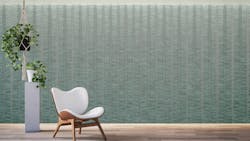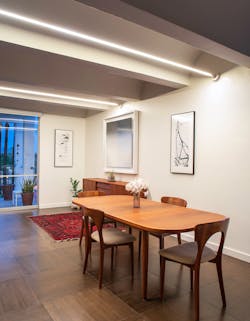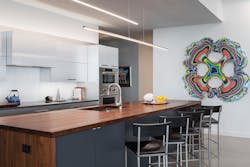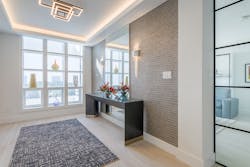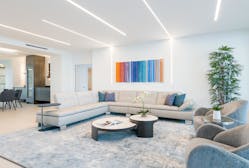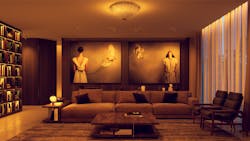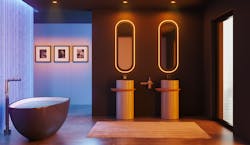Architectural lighting design is not immune to trends, which can change annually and even seasonally. For a building owner or designer seeking a long-term investment and product with staying power, Architectural SSL spoke with three industry experts on their go-to design moves—which, spoiler alert, often include not rules of thumb, but rather lines of inquiry.
Clean lines and quiet lighting
In the early stages of design development, Chad Rothe, owner and founder of Lightform Lighting in Scottsdale, Ariz., brings clients, architects, and interior designers into his approximately 3,000-square-foot showroom. If the visitors have done any prior research on Lightform Lighting, they will know the firm’s designs are “extremely modern and technical,” Rothe says. Still, he will ask clients for their aesthetic preferences as well as how they intend to use the space.
For products that require a clean installation, like a minimalist fixture with no visible infrastructure, Rothe and his team will lay out approximate locations on the drawings before walking the site with electricians to determine where exactly to locate drivers, receivers, controls, and power supply and to ensure everything is accessible for maintenance.
In kitchens, Rothe estimates that 90% of residential lighting designs show individual junction boxes for pendant lighting. “What I do is get rid of the pendants and do something linear,” he says. “A lot of times, the kitchen island and dining table are in the same vicinity, and [the designer or owner] wants a decorative element over both.” He prefers one or the other, though he makes an exception for linear fixtures, which he will specify for both locations. “If [the look is] too minimal,” he adds, “then we can create a cool array of [linear fixtures] overlapping at different sizes and lengths.”
Though Rothe personally tends toward “incredibly avant-garde and modern” luminaires, particularly the work of Italian architect and designer Achille Castiglioni, he also enjoys highlighting architectural elements and materials. “Indirect lighting,” Rothe says, “is the most quiet approach to lighting, meaning that one sees the lighting effect without seeing the actual fixture itself.”
For bathroom or shower walls with textured tile, Rothe demurs at recessed cans. “I recommend a 3-inch-by-3-inch shade pocket along the [tiled wall]. I then take the tile up that additional 3 inches and then put in [a wall grazer] with a 10-degree lens that is either surface mounted or recessed into the drywall. … It grazes the texture tile gently.” And when all other lights in the room are off, the space looks like a spa, he says. “It’s gorgeous.”
Rothe is always on the lookout for new products to curate for Lightform Lighting’s showroom, which goes through an overhaul at least annually. “Our window display is absolutely incredibly impactful and situated on one of the busiest streets in town,” he says. Though he knows his modern tastes may not appeal to those of every client, Lightform Lighting lead designer Abbie Bruch-Peterson brings in “a few transitional pieces, against my better judgment, because we also have to cater to the masses and what sells. It’s a team effort.”
Question everything, preferably before closing the ceiling
Visitors to Light Up Your Life’s 6,000-square-foot showroom in Sarasota, Fla., need not worry about walking into a space brimming with “chandeliers and fans,” says co-owner and lighting designer Monika Oberer. “It’s a very slick destination, and people can come in for both a lighting design and walk out with a fixture.”
When Oberer works with design professionals, she first updates them on the latest lighting technologies and capabilities, as well as on her lighting approach. “Designers often don’t know how to [light] in a discrete way,” she says. “We work closely with them to understand how they want to use their spaces. We don’t light up a room just to light it up. For us, lighting is emotional.”
In an exercise and yoga room, for example, she might include a ceiling fan and perimeter fixtures to keep users comfortable and to limit glare when they’re doing floorwork.
Knowing a wall is destined for artwork is not enough. Oberer will press further: “What exactly are you putting on the wall? Are you a collector? Do you need the whole wall lit all the time, or is it one centerpiece?”
Similarly, she won’t commit to rules of thumb, like hanging a dining table fixture 36 inches above the tabletop. Instead, she will ask, “What is behind the table? Is there a piece of art or a window with light coming in? Are you hanging up a slick piece of glass or a big crystal chandelier? Is the table round, square, rectangular, glass?” Each answer can change the ideal fixture position significantly.
Oberer recommends owners reach out to lighting designers early on in their project and preferably while ceilings are open, revealing structural elements and ductwork. “Lighting should be in the first go-around of designing a project,” she says. “Then the owners can get what they want rather than an, ‘OK, let’s just put it there.’”
Frequently, her clients do not know what look they want or how exactly they will use a space. That’s where owning a showroom becomes handy. Not only can visitors see a fixture in person and in use, but Oberer also has insight into its installation. “We’re the guinea pig,” she says, for a few electricians with whom she regularly contracts and to whom she can then refer her clients.
Finally, Oberer stays mindful of costs not only for the fixtures themselves, but also their installation. “If I have a product that is easy to install and a similar product from a different vendor that is harder to install but ¼ inch thinner, I’m not going to [specify] that one because my client's going to pay more money for the install,” she says. “If it gives me the same end result on the lighting, that's what counts for me.”
Good, better, and best must-haves
An electrician by trade, Gregory Kay has been designing products for more than 35 years, first at Tech Lighting and then with PureEdge Lighting, which he founded initially as two companies in 2006; he also serves as CEO. Kay recommends lighting designers create spaces that are “functional, yet also evoke emotion for different times of the day and for various settings. Designers should consider the color of light, whether it is bright white or golden warm. Pastels or bold, saturated colors can also play a role in creating a mood for a space.”
Kay advocates for layered lighting, which he describes as specifying more than just a pendant or decorative lighting, but also task lighting, such as undercabinet lighting; ambient lighting, such as recessed architectural lighting; and accent lighting, such as downlights or track lighting.
Every residence, Kay believes, should have some form of warm dim lighting, which replicates the effect of dimming with halogen sources from, for example, full brightness at 3000K or 4000K to 1800K. Even better, Kay says, is a product with tunable white, which can be set “from bright daylight white at 6000K to warm amber at 2000K, to help with circadian rhythm. All tunable white lights can dim to warm.”
For luxury residential or hospitality projects aiming to go above and beyond, Kay recommends smart lighting, which can be controlled through multiple devices, wall switches, or via voice. This lighting technology can offer tunable white as well as color-changing capabilities.
The advanced features are more expensive, but Kay believes the investment is worthwhile. “Warm dim costs about 5% to 20% more than cold dim LEDs, and [smart lighting with tunable white and color-changing capabilities] can be 10% to 30% more. … Considering these lights will last 20 years, and winters in the Northern states are long and dark, it is a small price to pay for emotional well-being.”
